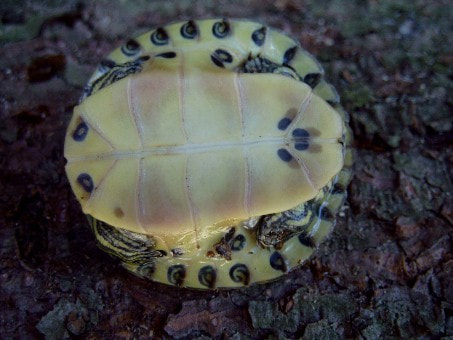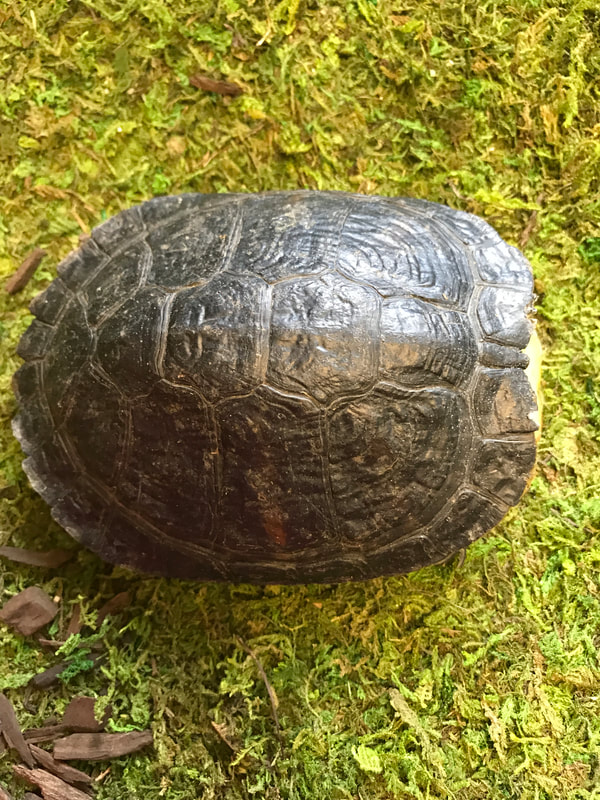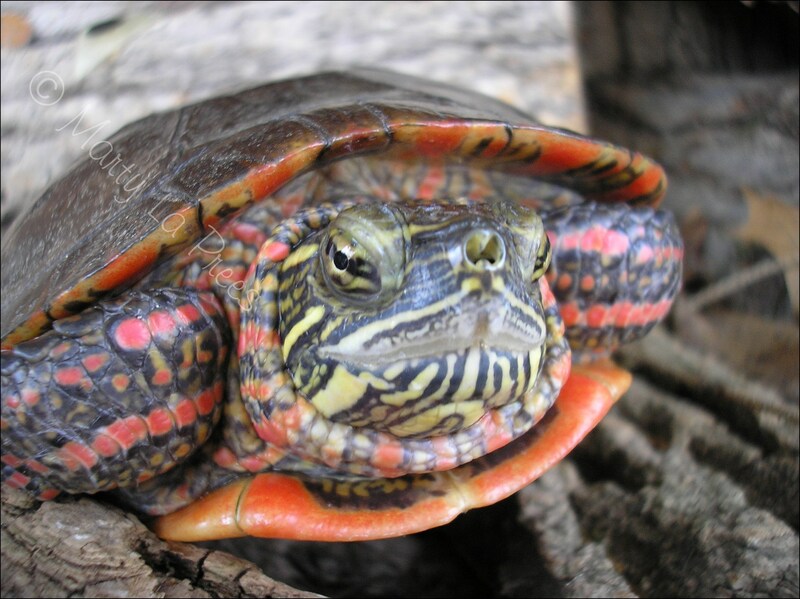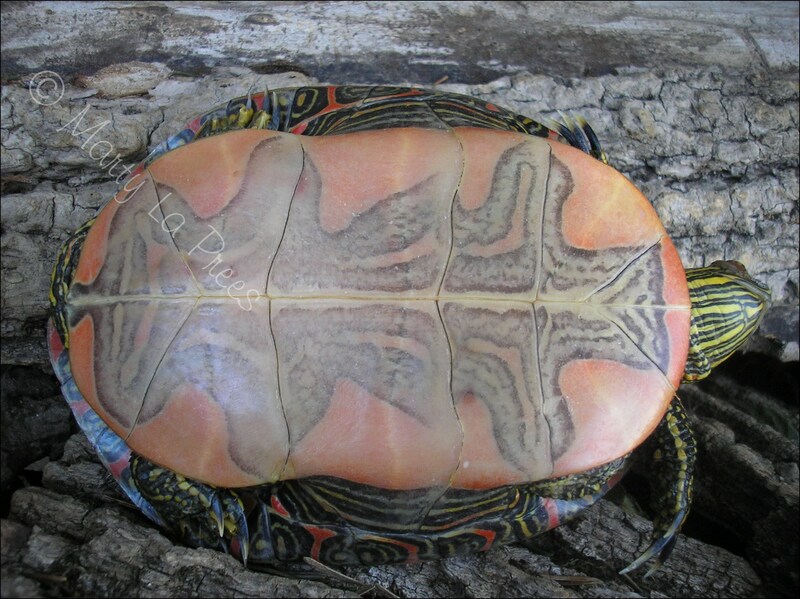Slider and Painted turtles

Red Eared Sliders (Trachemys Scripta) and Yellow Belly Sliders are in a large group totally up to 19 subspecies. They are the most common in the pet trade. They are found in the southeastern and part of the southwestern part of the USA extending north into the midwestern states. They are a fairly large turtle averaging 8 to 12" in length with females larger than males. They are easily identified by the large red patch on each side of the head. The carapace is oval, olive to brown with yellow stripes or bars. The plastron is yellow with dark blotches on each scute. It is also hinge less. The skin is green to brown with yellow stripes. A frontal arrow is formed on the head, passing forward from the eyes to meet a yellow stripe on top of the snout. Adult males become darker, losing their red markings on the face as well as the yellow markings on the carapace. Adult males have long, curved front claws and thick tails. They live in freshwater habitats with quiet water, soft bottoms and aquatic plants. Their diet consists of various plants along with worms, snails, insects and shrimp. Their predators can be raccoons and coyotes. Juveniles are eaten by fish, frogs and wading birds. Courtship is in the water, where the males begins to follow a female to mate with. Part of the behavior is the male swimming to the front of the female and vibrates his long-nailed front claws along the side of her head. He then returns to the back to mate with her. Nesting of the female is in April to July, depending on location. Not all females every year with some laying as many as 5 clutches. They will lay 2 - 24 eggs. Incubation times can be 65 - 90 days. The hatchlings are green with the red marking on the face very noticeable. They were sold in small plastic containers years ago, and labeled 'The Dime Store' turtle because they were frequently sold with a plastic bowl in what were drug stores years ago. Unfortunately, it was for profit as they were rarely taken care of properly. It is now illegal for them to be sold because of the possibility of contacting salmonella.
Yellow Belly Sliders
Yellow Belly Sliders (Trachemys Scripta Scripta) is a turtle that is found from Virginia to northern Florida. It is the most common aquatic turtle found there. The skin is olive green with prominent patches of yellow down the neck and legs. It has a wide yellow marking on each side of its head instead of a red marking that the Red Eared Sliders have. It's carapace is somewhat domed with yellow stripes on some of the scutes. It has a yellow stripe on the head the joins with a neck strip. The yellow plastron has dark smudges only on a few of the front scutes. The male reaches 5-9" in length with the females 8-13". Mating occurs in the water. The female will lay 6-10 eggs with an incubation time of 2 to 3 months, depending on temperature and weahter conditions. Their diet and habitat is the same as the Red Eared Sliders.
These two species of sliders are heavily bred for profit and in some states, illegal to sell. Here at Indiana Turtle Care, we are often contacted by owners to take their pet sliders because they no longer could care for them and 'no one told me that they need so much care and get so large', reasons. We no longer accept them due to space and time.
These two species of sliders are heavily bred for profit and in some states, illegal to sell. Here at Indiana Turtle Care, we are often contacted by owners to take their pet sliders because they no longer could care for them and 'no one told me that they need so much care and get so large', reasons. We no longer accept them due to space and time.
Painted Turtles
Midland Painted Turtle Midland Painted Plastron Western Painted Turtle Western Painted Plastron
Chrysemys Picta is the scientific name for the Painted Turtle. It is a small turtle with red markings on the marginal scutes and a notched upper jaw. Its carapace is smooth, oval, flattened and keelless with no serrated rear. It is olive to black with yellow or red boarders along the seams and red bars on the marginals. The yellow plastron is hingeless and has a black or reddish-brown blotch of varying size and shape. The skin is black to olive with the neck, legs, and tail red or yellow striped. The chin is marked with 2 wide yellow stripes which meet at the tip of the jaw. Males have long front nails and no concavity to the plastron. These turtles prefer slow-moving shallow water. A soft bottom, basking sites and aquatic vegetation are preferred. Painted turtles are omnivorous. In captivity, they enjoy romaine lettuce, cantaloupe, fresh and canned fish, earthworms, frozen shrimp and commercial trout chow along with Reptomin. It is the only North American turtle that ranges across the entire country. There are 3 species of painted turtles in Indiana.
Eastern Painted Turtle (Chrysemys Picta Picta) This subspecies has the vertebral and pleural carapacial
seams aligned with light border and an unmarked yellow plastron. The marginals are weakly patterned on
carapacial side but brightly patterned with red circles on plastral side; The head is black with 2 round to oval
bright-yellow spots behind the eyes. Narrow yellow stripes on head are below the eyes and on the chin.
The neck has a narrow red stripes as well as the limbs.
The tail is dark brown to black with narrow red stripes or dashes.
Midland Painted Turtle (Chrysemys Picta Marginata) The vertebral and pleural seams are in an alternating patter, with dark-boardered seams and a dark figure on the plastron. It is no more than half the width of the plastron and does not extend outward along the seams. The skin color is black to green with red stripes on the front legs. The head and throat have prominent yellow lines running from the tip of the nose and mouth downwards across the face. These lines will often turn red as they progress down towards the neck.
Western Painted Turtle (Chrysemys Picta bellii) This is the largest of the painted turtles and has alternating vertebral and pleural seams. A netlike pattern of light lines is on the carapace. The large dark figure on the plastron branches outward along the seams to occupy most of the surface.
seams aligned with light border and an unmarked yellow plastron. The marginals are weakly patterned on
carapacial side but brightly patterned with red circles on plastral side; The head is black with 2 round to oval
bright-yellow spots behind the eyes. Narrow yellow stripes on head are below the eyes and on the chin.
The neck has a narrow red stripes as well as the limbs.
The tail is dark brown to black with narrow red stripes or dashes.
Midland Painted Turtle (Chrysemys Picta Marginata) The vertebral and pleural seams are in an alternating patter, with dark-boardered seams and a dark figure on the plastron. It is no more than half the width of the plastron and does not extend outward along the seams. The skin color is black to green with red stripes on the front legs. The head and throat have prominent yellow lines running from the tip of the nose and mouth downwards across the face. These lines will often turn red as they progress down towards the neck.
Western Painted Turtle (Chrysemys Picta bellii) This is the largest of the painted turtles and has alternating vertebral and pleural seams. A netlike pattern of light lines is on the carapace. The large dark figure on the plastron branches outward along the seams to occupy most of the surface.










